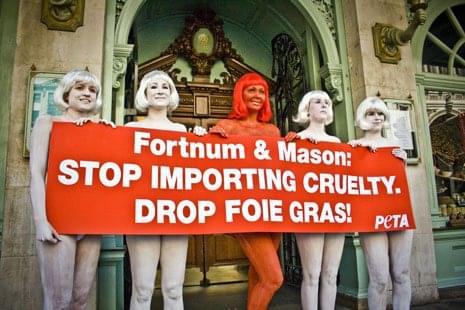Chefs mount a repeal of foie gras ban
The countdown to foie-mageddon has begun. With less than a month until California’s first-in-the nation ban on foie gras takes effect, fans of the fattened duck and goose liver are buying out stocks of the delicacy, searching for legal loopholes and sating themselves at a series of foie-heavy goodbyes.
“We want to get our fill before it’s gone,” said Terrance L. Stinnett, a lawyer from Alamo, Calif., who attended a farewell lunch here recently. “This is a wake.”
July 1 is the start date of the hotly debated and divisive ban, which prohibits the sale of any product derived from the force-feeding of birds to enlarge their livers — the most common way to mass-produce foie gras. . (The law was passed in 2004, but included a seven-and-a-half-year grace period.)
As the deadline approaches, some of the best-known chefs in California — including Thomas Keller, Gary Danko and Michael Mina — have been mounting a repeal effort and promising new ethical standards. But they are also making practical preparations for the likelihood that they won’t be able to overturn the law before it takes effect. Even opponents of the ban say going to bat for high-priced foie gras, after all, isn’t exactly an easy political stance in an age of animal rights and fiscal austerity.
So how will chefs replace foie gras, with its butter-soft texture and rich, subtle taste? The short answer, they say, is that they can’t, and the sense of loss is palpable.
“It’s unlike any other animal product that I know of,” said Jon Shook, an owner of Animal, a meat lovers’ paradise in Los Angeles where foie gras regularly appears in sauces, as a torchon and in other forms. “We’re working on dishes to replace it, but you can never really replace foie gras.”
That sentiment was echoed by Michael Ginor, an owner of Hudson Valley Foie Gras in Ferndale, N.Y., who likened it to delicious Play-Doh.
“You can shape it into anything you want,” he said. “You can sauté it, you can serve it cold, you can serve it hot, you can cook it at high heat.”
You get the idea. The menu at an April lunch at the Pebble Beach Food and Wine festival was indicative of the product’s versatility across land and sea, entree and dessert. Prepared by several opponents of the ban, the meal featured oysters and raw foie gras; lobster and foie gras noodles (created by squeezing liquid foie gras into a broth); beef tenderloin with seared foie gras and a foie gras emulsion, and vanilla and foie gras crème brûlée.
As that suggests, foie gras is not for the weak of heart or the high of cholesterol. Mr. Ginor said that ducks are much more commonly used today because geese are more labor intensive, more susceptible to disease and temperamental, all factors that make the ducks “more economically sensible” to use, though some believe the taste of goose foie gras is more delicate.
Casey Lane, the chef at the Tasting Kitchen in Los Angeles, said his restaurant almost never serves a portion of foie gras smaller than six to seven ounces, making the dish “a genuine indulgence.” He might counter the dish’s richness with the sweetness and acidity of a peak-of-the-season apple.
“It’s like having the trump card year round,” he said.
He, too, bemoaned its loss. “The people that build Porsches, you don’t want your gasoline taken away from you,” he said. “You’re trying to work at the top of your field.”
Beyond the kitchen, there are other responses in the works, including whispers of culinary civil disobedience, in which restaurateurs would continue to serve the dish — and risk fines of up to $1,000 per violation. Others have suggested that they could skirt the law by offering the foie gras free (with $20 glasses of wine).
The end result, however, will likely be very little, if any, foie anywhere in California. And that disheartens people like Greg Daniels, who runs the Haven Gastropub in Pasadena, Calif., and worries about the state’s culinary reputation. “How seriously can you take our culinary efforts when we can’t even use this product that’s being used everywhere?” he said.
You can read the rest of the article at New York Times if you click here>>
Related news
Related news
We are optimistic at the end of 2025
🎧 Hallgasd a cikket: Lejátszás Szünet Folytatás Leállítás Nyelv: Auto…
Read more >Anti-drug regulations for restaurants to be relaxed from 2026
🎧 Hallgasd a cikket: Lejátszás Szünet Folytatás Leállítás Nyelv: Auto…
Read more >







